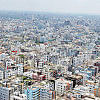Dhaka needs a hydraulic vision

Dhaka is a paradox. The more we build assuming we are "developing," the more we dig ourselves into an urban mess: Transportation is a chaos. Travelling is a nightmare. Khals vanish, and roads turn to khals. Public space is non-existent. Housing is in disarray.
The current crisis of Dhaka results from three inadequacies: lack of an integrated vision from the various policy- and decision-makers who nonetheless bring changes to the city; inadequate solutions by planners and technocrats unable to take up the challenges of the toughest city in the world; and lopsided priorities in deciding what should be tackled first (example: MRT should have received the highest priority in infrastructure development and not elevated roadways). Moreover, with advisements and funding from a global network of development entities, it appears that Dhaka's destiny no longer belongs to itself.
A good city is envisioned, designed and meticulously planned which then is diligently implemented; this may sound obvious but there simply is no other way out of this. While there should be latitudes in design, a city begins and proceeds with a plan, one that has both poetry and pragmatism. Development and investment should follow a plan (in Dhaka, it is the other way round). And plans should be based on "urbanism," on the quality of civic culture and lived experiences, and not on a set of abstract statistics, and economic and technocratic arguments. Such vision-making requires a deeper understanding of the history and nature of cities in the broadest sense, and an abiding knowledge of the particularities of Dhaka – there are particularities of Dhaka that belong only to her.
Knee-deep in one city, and neck-high in another, with citizens drowning and swimming, this is perhaps the right time to utter what is special to Dhaka: water!
What conventional planning models and development trends lack is an understanding of the hydrological and ecological landscape of Dhaka, and the need for creative responses to that. Regular planning considers the city from a high and dry vantage point; I call this "dry planning," in which the city is civilised if it is dry, and primitive and backward when wetness prevails. The outcome: Water as the basis of a rich community life has evaporated. The river has become a drain. The wetland has become a swamp. And the monsoon has become just a miserable season.
"Most urban planners and policymakers focus on the core city. Even when they are dealing with the edge, they see it in the image of the dry core. Official planning is unable to conceptualise this edge as a distinctive ecology of a hydraulic nature.
Planning around land and water—and not land versus water—is the only natural recourse in this particular landscape. An understanding of that requires a simple science, and not a rocket science. However, it needs to begin with an acceptance that in this incredibly fluctuating landscape called the Bengal Delta where water rises and falls, comes and goes, flows and overflows, and constantly shifts boundaries between settlement and land/waterscape, a new intellectual position is required: What should be the perimeter of the city when Dhaka grows indefinitely in every other direction, swallowing up wetlands and agricultural lands, and throwing off balance a precious ecological and hydrological system? What will happen at that edge? How will population growth and the appetite for dry land be solved? The challenge for urban designers, planners and policymakers will be to show how growth can be addressed by sustaining and enhancing Dhaka's crucial hydro-geographic system.
Dhaka's eastern fringe is symptomatic of a problematic planning. Bengalis have lived with flood on floodplains for thousands of years, but now that they are getting urbanised, and dream of "plots" and "flats,"they have little clue how to build cities on such landscapes. Areas characterised by canals, ponds, waterways, wetlands and agricultural fields, ultimately linked to the rhythm of rivers—all of which are the original stuff of Dhaka—are being aggressively changed by ruthless land-filling. All in the name of "model towns" and "housing societies" (The irony is that these projects are neither models nor provide housing in the basic sense). This is an example of Dhaka's ecologically disastrous urbanisation, demonstrated in the plans for Purbachal, and continuing all the way to Balu and Sitalakhya rivers!
People who dwell in the core of Dhaka city, walk its streets and live its dry conditions, may not be aware that current development work is based, literally, on liquid matter. Present Dhaka is being built from the fluid fabric of its surrounds by piping and pumping soil and sand. In Dhaka's furious expansion from its relatively higher grounds into the precious region of floodplains, wetlands and "lowlands," vast aquatic areas are being filled up in an unprecedented scale of urbanistic intervention. In fact, all around the city, sand and debris cover once fields of mustard and rice, and concrete and steel rods replace the vernacular of bamboo and thatch. Multi-storied buildings hum with the music of a far-off Gap or Walmart. Freshly laid sand-beds announce the arrival of a Japan City, American City, Green City... When an aquatic landscape at the fringe rapidly transforms into a hodge-podge urbanisation, strange things will happen. Khals, nalas, dobas and pukurs—the lowlands—will get filled to shore up tottering towers, without any basic recourse to safety and buildability, and petit goons with the blessings of big leaders become millionaires, and enter the mystical chain of globalisation. Recall Rana Plaza!
Liberal economy, private investments, and burgeoning consumer markets have ushered both new opportunities and unprecedented challenges making Dhaka the most expensive real estate lot in the country. But this comes without a clear urban vision and commitment of wellbeing for everyone and everything.
The question of water is not simply dealing with water-clogged streets in monsoon, but working out how the city should work with water in its deepest structural and organisational sense. The first relates to the second.
It is at that juncture, where the expansion of the city meets an aquatic matrix, a new kind of city-thinking is needed: a new imagination for a hydraulic urbanism. A hydraulic vision has to begin from the edge of the precious landscape of wetlands and agricultural terrain, ushering a conception of a city that integrates urbanism, agriculture, and flood behaviour. In such a plan, water structures the city and urban infrastructure in which hydrological issues serve as the starting point and framework for urban planning and design interventions. In that ecologically-driven schema, it is possible to think of "bringing the city into the floodplain and the floodplain into the city." Solutions may involve a new network of careful development—streets, walkways, housing and public places—elevated either on stilts or non-continuous earth mound over agricultural fields, gardens and parks. The porosity at the lower level will allow an unimpeded flow of water at different seasons. Seasonal flooding and overflow may actually be allowed in an organised manner for special areas that in dry seasons will become public spaces.
In his cartography of the contemporary city, the renowned Dutch architect Rem Koolhaas defined the "edge" of the Euro-American city as a frazzled fabric of post-industrial conditions or the tattered terrain of suburbia.
In Dhaka, the edge or fringe is the critical site of the next urban dynamic (or battlefield). That geography is characterised by the built-city marching up to meet the "non-urban," a magnificent but precious terrain of land-water mass. The edge is where the dry meets the wet, the "developed" meets the "primitive," and infrastructure meets the structure-less. This is the zone where the urbanite meets the farmer, the land grabber discovers his opportunity, and the uprooted often makes her habitation.
Most urban planners and policymakers focus on the core city. Even when they are dealing with the edge, they see it in the image of the dry core. Official planning is unable to conceptualise this edge as a distinctive ecology of a hydraulic nature. Without that realisation it is easy to participate in the destruction of the city's hydro-geographical landscape.
Nothing short of imagining a new landscape of city-form will offer salvation for Dhaka. The edge conditions of Dhaka present the possibility of re-negotiating the social and economic, as well as conceptual, separation between city and its conventional anti-thesis, whether the village or agricultural landscape. The edge is where new forms of space organisation in response to an oscillating landscape will have to be reorganised, along with newer types of economic, social and architectural opportunities. In the meeting of an older form of the city with agricultural land-form and hydrological landscape, a new conception of a city will have to be developed that integrates the city with agriculture, infrastructure and flood-form. For that, Dhaka has to be built with the dynamics of water.
It is for those reasons Dhaka needs a new model of the city. A pornographic image of Dubai or Shanghai, where a brutal consumerist economy dictates everything, or the dubious liberality of Gurgaon or Noida, where maids riot against their mistresses, will not help us build a city on and with water. Are we ready to imagine such a city-form?
Kazi Khaleed Ashraf is an architect, urbanist and author, and heads the Bengal Institute for Architecture, Landscapes and Settlements.









Comments